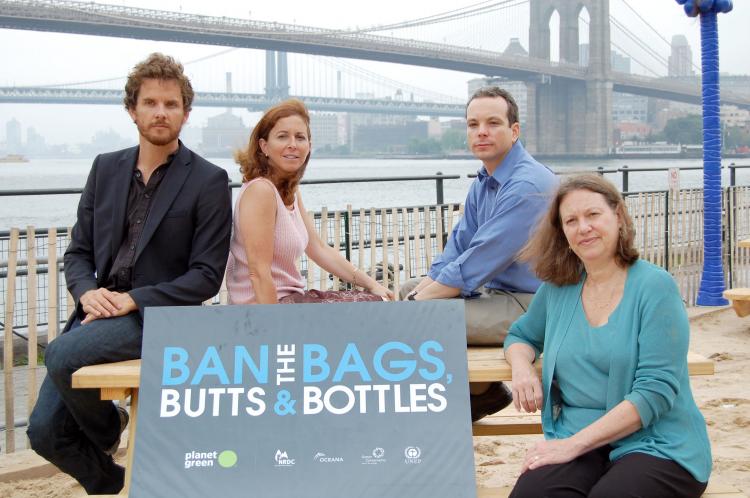NEW YORK—Pollution of area beaches is getting worse and endangers beach goers, according to the Natural Resources Defense Council’s (NRDC) 19th annual beach water report released on July 27.
New York and New Jersey experienced 1,818 beach closings and advisories in 2008, according to “Testing the Waters: A Guide to Water Quality at Vacation Beaches” released by the NRDC.
According to NRDC’s report, beachwater pollution makes swimmers vulnerable to a range of waterborne illnesses including stomach flu, skin rashes, pinkeye, ear, nose and throat problems, dysentery, hepatitis, respiratory ailments, neurological disorders and other serious health problems. For senior citizens, small children, and people with weak immune systems, the results can be fatal.
“We need to stop using the ocean as our dumping ground and prevent this type of pollution from reaching our shores and risking our health”, said Sarah Chasis, director of NRDC’s Oceans Initiative at a press conference held at South Street Seaport.
NRDC argues that “Most of New York City’s beach closings and advisories were pre-emptive. These occur when, for example, the city’s sewer system discharges raw sewage directly into the area’s waterways. As little as one-tenth of an inch of rainfall can trigger these releases. The majority of the city’s sewers collect both sewage and storm runoff, but they overflow when it rains, dumping about 27 billion gallons of this bacteria-laden mix annually into the waters around the city, from about 460 overflow points in all five boroughs.”
The NRDC also claims that another major factor accelerating the pollution is climate change. “Specifically, climate change is anticipated to influence the presence of pathogens that cause stomach flu, diarrhea and neurological problems in America’s beach water.”
What can be done?
Adrienne Esposito, executive director of Citizens Campaign for the Environment, shared her viewpoint that there are solutions available—the problem is that they are not being enacted.
“We can send astronauts to the moon and a probe to Mars, and yet we haven’t decided to filter storm water to protect our beaches and bays,” said Esposito. ”There are a myriad of new design techniques and low tech options that offer meaningful storm water filtration advantages. The simple truth is that most municipalities have not made beach protection a priority.”
Toward the right direction
Although the situation is getting worse every year, Larry Levine, an attorney in NRDC’s New York office said that New York City is moving in the right direction by making plans to enact change. “New York and all cities, towns, and local governments can turn green infrastructure into standard practice through smart policy changes, such as revamping local codes and redesigning of public works projects,” said Levine.
Another project that is attempting to drive the city toward a change in this regard is Discovery’s Planet Green Channel, an NRDC partner. As part of its Blue August, a month-long, multi platform programming initiative on all things aquatic, Discovery Planet is launching their “Ban the Bags, Butts and Bottles Challenge!” which invites communities to become part of the solution.
In hopes that the people of New York will understand the priority of this issue and take the responsibility into their hands, the NRDC is offering s a few tips to get started:
1. Be a good steward at the beach.
2. Clean up after your pet.
3. Conserve water.
4. Direct runoff to the soil, not the street.
5. Don’t pour hazardous products down the drain.
6. Maintain your septic system.
7. Practice proper lawn and garden care.
8. Practice proper marine and recreational boating waste disposal.
9. Support local, state, and federal legislation that promotes the cleanup of pollution sources.
10. Learn about the water quality at local beaches and choose your beach carefully.
New York and New Jersey experienced 1,818 beach closings and advisories in 2008, according to “Testing the Waters: A Guide to Water Quality at Vacation Beaches” released by the NRDC.
According to NRDC’s report, beachwater pollution makes swimmers vulnerable to a range of waterborne illnesses including stomach flu, skin rashes, pinkeye, ear, nose and throat problems, dysentery, hepatitis, respiratory ailments, neurological disorders and other serious health problems. For senior citizens, small children, and people with weak immune systems, the results can be fatal.
“We need to stop using the ocean as our dumping ground and prevent this type of pollution from reaching our shores and risking our health”, said Sarah Chasis, director of NRDC’s Oceans Initiative at a press conference held at South Street Seaport.
NRDC argues that “Most of New York City’s beach closings and advisories were pre-emptive. These occur when, for example, the city’s sewer system discharges raw sewage directly into the area’s waterways. As little as one-tenth of an inch of rainfall can trigger these releases. The majority of the city’s sewers collect both sewage and storm runoff, but they overflow when it rains, dumping about 27 billion gallons of this bacteria-laden mix annually into the waters around the city, from about 460 overflow points in all five boroughs.”
The NRDC also claims that another major factor accelerating the pollution is climate change. “Specifically, climate change is anticipated to influence the presence of pathogens that cause stomach flu, diarrhea and neurological problems in America’s beach water.”
What can be done?
Adrienne Esposito, executive director of Citizens Campaign for the Environment, shared her viewpoint that there are solutions available—the problem is that they are not being enacted.
“We can send astronauts to the moon and a probe to Mars, and yet we haven’t decided to filter storm water to protect our beaches and bays,” said Esposito. ”There are a myriad of new design techniques and low tech options that offer meaningful storm water filtration advantages. The simple truth is that most municipalities have not made beach protection a priority.”
Toward the right direction
Although the situation is getting worse every year, Larry Levine, an attorney in NRDC’s New York office said that New York City is moving in the right direction by making plans to enact change. “New York and all cities, towns, and local governments can turn green infrastructure into standard practice through smart policy changes, such as revamping local codes and redesigning of public works projects,” said Levine.
Another project that is attempting to drive the city toward a change in this regard is Discovery’s Planet Green Channel, an NRDC partner. As part of its Blue August, a month-long, multi platform programming initiative on all things aquatic, Discovery Planet is launching their “Ban the Bags, Butts and Bottles Challenge!” which invites communities to become part of the solution.
In hopes that the people of New York will understand the priority of this issue and take the responsibility into their hands, the NRDC is offering s a few tips to get started:
1. Be a good steward at the beach.
2. Clean up after your pet.
3. Conserve water.
4. Direct runoff to the soil, not the street.
5. Don’t pour hazardous products down the drain.
6. Maintain your septic system.
7. Practice proper lawn and garden care.
8. Practice proper marine and recreational boating waste disposal.
9. Support local, state, and federal legislation that promotes the cleanup of pollution sources.
10. Learn about the water quality at local beaches and choose your beach carefully.




